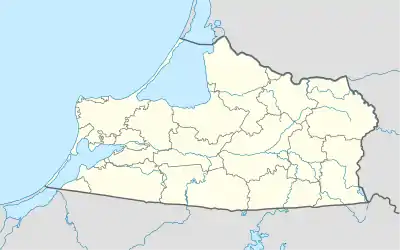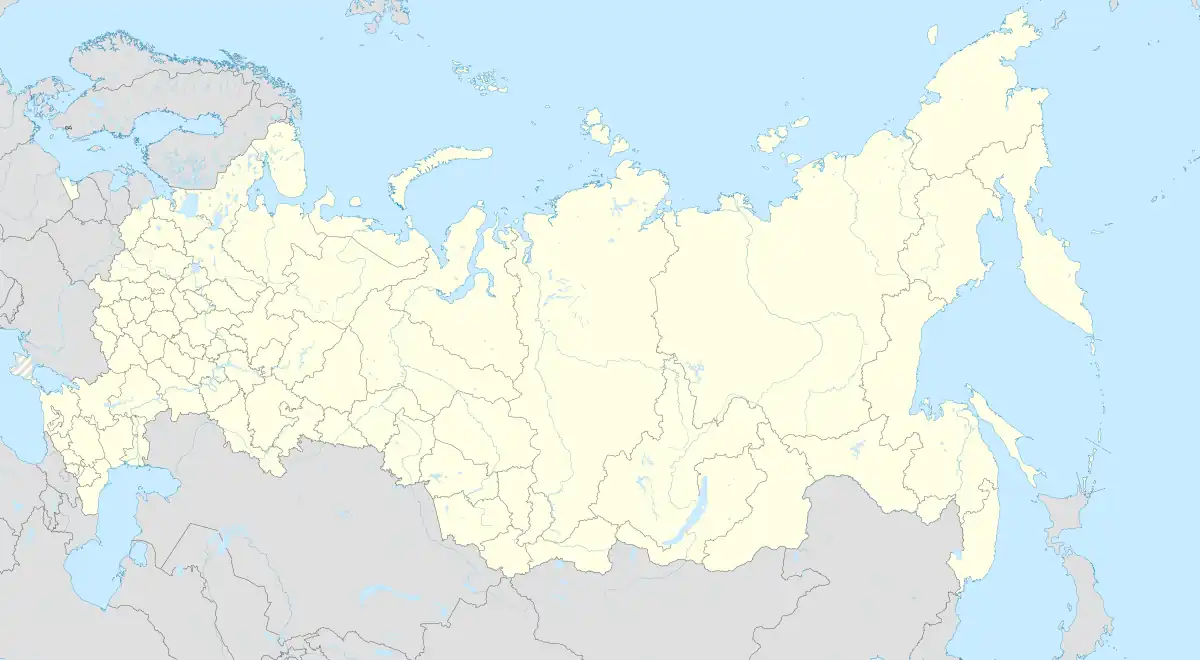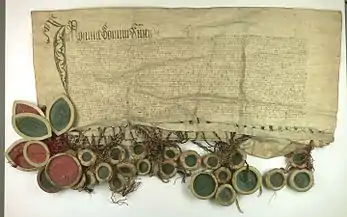Mamonovo
Мамоново | |
|---|---|
 Water tower in Mamonovo | |
.png.webp) Coat of arms | |
Location of Mamonovo | |
 Mamonovo Location of Mamonovo .svg.png.webp) Mamonovo Mamonovo (European Russia)  Mamonovo Mamonovo (Europe)  Mamonovo Mamonovo (Russia) | |
| Coordinates: 54°27′50″N 19°56′29″E / 54.46389°N 19.94139°E | |
| Country | Russia |
| Federal subject | Kaliningrad Oblast[1] |
| Founded | 1301 (Julian) |
| Elevation | 15 m (49 ft) |
| Population | |
| • Total | 7,761 |
| • Estimate (2018)[3] | 7,953 (+2.5%) |
| • Subordinated to | town of oblast significance of Mamonovo[1] |
| • Capital of | town of oblast significance of Mamonovo[1] |
| • Urban okrug | Mamonovsky Urban Okrug[4] |
| • Capital of | Mamonovsky Urban Okrug[4] |
| Time zone | UTC+2 (MSK–1 |
| Postal code(s)[6] | 238450 |
| OKTMO ID | 27712000001 |
Mamonovo (Russian: Мамоново, German: Heiligenbeil,[7] Polish: Święta Siekierka or Świętomiejsce; Lithuanian: Šventpilis; Prussian: Swintamīstan), is a town in Kaliningrad Oblast, Russia. Population figures: 7,761 (2010 Census);[2] 7,393 (2002 Census);[8] 7,816 (1989 Census).[9]
Etymology
Mamonovo is named after a Soviet Commander, Nikolay Mamonov, killed in action near Pułtusk on October 26, 1944, who was posthumously awarded the title Hero of the Soviet Union on March 24, 1945.
History


Under the Teutonic Knights Heiligenstadt was built near an Old Prussian settlement. It was later renamed Heiligenbeil after a holy axe used by Augustinian monks, established in the area by Grand Master Winrich von Kniprode after the Battle of Rudau, to cut down an oak tree worshiped by pagan Prussians.[10] It came under the bishopric of Warmia, then to the territory of Natangia. Since 1440, the town was a founding member of the anti-Teutonic Prussian Confederation, upon the request of which, Polish King Casimir IV Jagiellon incorporated the region and town to the Kingdom of Poland in 1454.[11] Then the Thirteen Years' War, the longest of all Polish–Teutonic wars, broke out, after which the region and town became part of Poland as a fief held by the Teutonic Knights,[12] and after 1525 held by secular Ducal Prussia. From 1701, the town was part of the Kingdom of Prussia, and from 1871 it was also part of Germany, within which it was located in the province of East Prussia.
During World War II, in 1944–1945, it was the location of the Heiligenbeil concentration camp, a subcamp of the Stutthof concentration camp, in which the Germans imprisoned around 1,100 Jewish women and 100 Jewish men as forced labour.[13] Towards the end of the war in fierce fighting between January and March 1945 the Heiligenbeil pocket fell to the Red Army. It was captured by Red Army on March 26, 1945, and was soon integrated into the Kaliningrad Oblast. It took its present name in 1946. The defending 4th Army's archives were buried in a forest near the town and found in 2004, in an area still littered with debris from the final battles.[14]
Administrative and municipal status
Within the framework of administrative divisions, it is, together with four rural localities, incorporated as the town of oblast significance of Mamonovo — an administrative unit with the status equal to that of the districts.[1] As a municipal division, the town of oblast significance of Mamonovo is incorporated as Mamonovsky Urban Okrug.[4]
Notable people
- Rudolf von Auerswald (1795–1866) in 1824 he acquired an estate in the Heiligenbeil District and became Landrat (district administrator)
References
Notes
- 1 2 3 4 5 Resolution #639
- 1 2 Russian Federal State Statistics Service (2011). Всероссийская перепись населения 2010 года. Том 1 [2010 All-Russian Population Census, vol. 1]. Всероссийская перепись населения 2010 года [2010 All-Russia Population Census] (in Russian). Federal State Statistics Service.
- ↑ "26. Численность постоянного населения Российской Федерации по муниципальным образованиям на 1 января 2018 года". Federal State Statistics Service. Retrieved January 23, 2019.
- 1 2 3 Law #395
- ↑ "Об исчислении времени". Официальный интернет-портал правовой информации (in Russian). June 3, 2011. Retrieved January 19, 2019.
- ↑ Почта России. Информационно-вычислительный центр ОАСУ РПО. (Russian Post). Поиск объектов почтовой связи (Postal Objects Search) (in Russian)
- ↑ M. Kaemmerer (2004). Ortsnamenverzeichnis der Ortschaften jenseits von Oder u. Neiße (in German). ISBN 3-7921-0368-0.
- ↑ Russian Federal State Statistics Service (May 21, 2004). Численность населения России, субъектов Российской Федерации в составе федеральных округов, районов, городских поселений, сельских населённых пунктов – районных центров и сельских населённых пунктов с населением 3 тысячи и более человек [Population of Russia, Its Federal Districts, Federal Subjects, Districts, Urban Localities, Rural Localities—Administrative Centers, and Rural Localities with Population of Over 3,000] (XLS). Всероссийская перепись населения 2002 года [All-Russia Population Census of 2002] (in Russian).
- ↑ Всесоюзная перепись населения 1989 г. Численность наличного населения союзных и автономных республик, автономных областей и округов, краёв, областей, районов, городских поселений и сёл-райцентров [All Union Population Census of 1989: Present Population of Union and Autonomous Republics, Autonomous Oblasts and Okrugs, Krais, Oblasts, Districts, Urban Settlements, and Villages Serving as District Administrative Centers]. Всесоюзная перепись населения 1989 года [All-Union Population Census of 1989] (in Russian). Институт демографии Национального исследовательского университета: Высшая школа экономики [Institute of Demography at the National Research University: Higher School of Economics]. 1989 – via Demoscope Weekly.
- ↑ Urban, William (2006). Samogitian Crusade. Chicago: Lithuanian Research and Studies Center. pp. 158–159. ISBN 0-929700-56-2.
- ↑ Górski, Karol (1949). Związek Pruski i poddanie się Prus Polsce: zbiór tekstów źródłowych (in Polish). Poznań: Instytut Zachodni. pp. XXXVII, 54.
- ↑ Górski, pp. 96-97, 214-215
- ↑ Gliński, Mirosław. "Podobozy i większe komanda zewnętrzne obozu Stutthof (1939–1945)". Stutthof. Zeszyty Muzeum (in Polish). 3: 178. ISSN 0137-5377.
- ↑ Koenigsberger Express Das Niemandsland gibt ein Geheimnis preis. Koenigsberger Express, ed. 2004/7
Sources
- Правительство Калининградской области. Постановление №640 от 30 августа 2011 г. «Об утверждении реестра объектов административно-территориального деления Калининградской области», в ред. Постановления №877 от 21 ноября 2011 г «О внесении изменения в Постановление Правительства Калининградской области от 30 августа 2011 г. №640». Вступил в силу со дня официального опубликования. Опубликован: "Калининградская правда" (вкладыш "Официально"), №170, 15 сентября 2011 г. (Government of Kaliningrad Oblast. Resolution #640 of August 30, 2011 On the Adoption of the Registry of the Objects of the Administrative-Territorial Divisions of Kaliningrad Oblast, as amended by the Resolution #877 of November 21, 2011 On Amending the Resolution of the Government of Kaliningrad Oblast #640 of August 30, 2011. Effective as of the day of the official publication.).
- Калининградская областная Дума. Закон №395 от 15 мая 2004 г. «О наделении муниципального образования "Город Мамоново" статусом городского округа», в ред. Закона №370 от 1 июля 2009 г «О составе территорий муниципальных образований Калининградской области». Вступил в силу со дня официального опубликования. Опубликован: "Российская газета" ("Запад России"), №115, 3 июня 2004 г. (Kaliningrad Oblast Duma. Law #395 of May 15, 2004 On Granting the Urban Okrug Status to the Municipal Formation of the "Town of Mamonovo", as amended by the Law #370 of July 1, 2009 On the Composition of the Territories of the Municipal Formations of Kaliningrad Oblast. Effective as of the day of the official publication.).